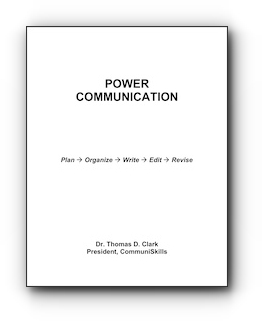
|
Power Communication
by Thomas Clark, Ph.D.
345 pages
|
How to write and speak persuasively to achieve organizational goals.
|
|
|
|
|
Ebook
|
$19.95
|
Download Ebook instantly!
(PDF format)
|
|
|
|
|
|
Category: Business:Communications
|
|
|
About the Book
|
|
Developed by
Dr. Tom Clark over a fifteen year period of teaching writing, presentation,
and small group communication skills at Procter & Gamble, (the business
thinking capital of the world), Power Communication provides you
with a systematic presentation of how to compose persuasive written
and oral messages. Organized around the acronym POWER, you'll
learn to Plan, Organize, Write, Edit, and Revise letters, memos,
e-mail, and presentations for effective communication.
POWER Communication includes the following:
Guidelines on how to write a one-page memo that clearly and concisely
communicates your ideas to your readers
Document design techniques that assist you in composing documents
that are well-designed and effectively adapted to the needs of readers.
POWER Communication will teach you how to design documents that
are attractive when skimmed and scanned, and logically argued when
read word for word.
A planning matrix that will help you write complex reports quickly
and efficiently.
Guidelines on communication in a multicultural environment that
help you develop appropriate writing and speaking styles.
Exclusive treatment of how to write to avoid litigation, exploring
legal issues in oral and written business communication.
A chapter of Model Documents which you can use as a starting point
for organizing a variety of business messages.
Procedures for defining your communication objectives by setting
quality control criteria that allow you to translate your objectives
into four observable and measurable standards.
Techniques for organizing your presentation by time blocks so you
spend an appropriate amount of time on issues most relevant to your
listeners.
Examples of effective presentation openings and closings to guide
you in the critical preview and review portions of a presentation.
Designing visual aids that illustrate your presentations effectively
without overwhelming them.
Using mental rehearsal to prepare for questions and objections in
advance of a presentation. Techniques for answering questions quickly
and effectively.
Learning how to relax physically and mentally, with progressive
relaxation, positive self-talk, and autogenic training.
Achieving vocal and visual effectiveness by practicing speaking
emphasis exercises.
Guidelines for rehearsing presentations.
Message planning aids including a helpful timetable for communication,
action step outlines and planning sheets for e-mail, voice mail,
memos, reports, group communication and oral presentations.
A comprehensive appendix that includes a compact guide to usage,
punctuation, spelling, and capitalization as well as discussions
of team writing and writing for another's signature.
Guidelines on how to write and speak with authority, with a special
focus on powerful and powerless speech.
Techniques for transforming negative communication into positive
communication.
Guidelines for effective editing and revising messages quickly and
efficiently, including messages written by co-workers and subordinates with
a focus on how to create and reinforce images of expertise, strategic
insight, goodwill, dynamism, power, and transparent thinking.
Examples of how to open meetings with an organized statement that
indicates to listeners that you are going to lead a well-organized
meeting that ends on time, with each item on the agenda receiving
appropriate analysis and follow-up.
|
| About the Author |
 |
Thomas Clark, Ph.D., is President of CommuniSkills and Professor of Management at Xavier University, Cincinnati, OH. For the past 23 years, he has taught writing and presentation skills at Procter & Gamble, the business writing capital of the world. He has won numerous awards for teaching and research. |
|


